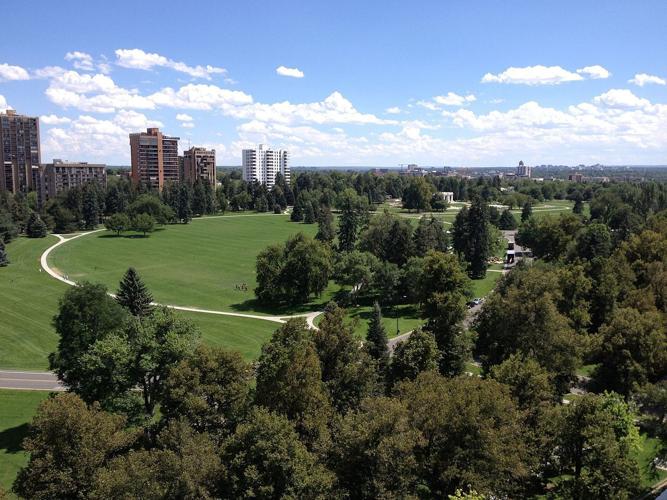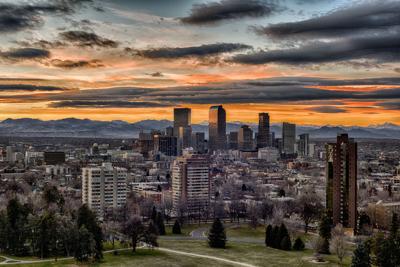Nestled between mansions found in the heart of the Mile High City, Cheesman Park is an urban green space that has attracted outdoor recreation-lovers for decades, with portions of the park opening as long ago as 1898. It spans 80 acres and is filled with trails, fountains, and close to 2,000 trees representing more than 50 species.
Of course, Cheesman Park hasn’t always been a place so aligned with growth and an active life. More than 100 years ago, overturned dirt didn’t mean a new resident had arrived at the park in the form of a sapling. Overturned dirt meant a new resident had arrived at the park in the form of skin and bones, placed six feet under and meant to stay for an eternity.
This former use of the land might be a little creepy, but that’s just the tip of a very disturbing iceberg.

Cheesman Park. Photo Credit: R0uge (Wikimedia Commons)
The land that’s now Cheesman Park was once used for a very different purpose – housing the remains of lost loved ones in a place those still living could visit. Originally dubbed Prospect Hill Cemetery and eventually called Denver City Cemetery, Cheesman Park acreage was used for this purpose from 1858 until 1890. However, it’s after 1890 that things got strange.
In January of 1890, a Colorado Senator named Henry Moore Teller convinced the US Congress to convert the cemetery that had largely fallen into disuse into a new city park – to be named Congress Park (the land has since been split into multiple parks by residential growth). At this point, family members with deceased relatives buried on the land were given a few months to move the bodies of their loved ones to another gravesite.
As you might expect, digging up a body and relocating it can be expensive. Some of the people that could afford to do so, did, while many others that couldn’t pay the associated costs simply left the bodies behind. It’s also worth mentioning that a lot of the people buried in this cemetery were also unclaimed from the point of their burial – criminals and transients that died in Denver while passing through.
As time ticked by, thousands of remains were left behind. Months passed and then years.
Eventually, city officials started to assume that no one was coming for those left decaying in the park.
With so many bodies left unclaimed, Denver had a decision to make. They wanted their park, but they also wanted their park to be free of dead bodies.
This is when they made the decision to hire an undertaker named E.P. McGovern to step in – in 1893. McGovern and 18 of his employees were to dig up and relocate roughly 5,000 bodies for a per-body fee of $1.90 (around $55 in 2021), putting each body in a new casket and transferring it to Riverside Cemetery – another Denver-area cemetery that's located approximately 5 miles away.
Though gruesome work, this plan seemed like an effective approach during the initial days of body transfers. McGovern would dig up a plot of land said to hold remains, he’d put the bodies in a casket, and then transfer them across town to their new permanent home. When all was said and done, he’d make around $9,500 – roughly $250,000 adjusted for inflation.
The process was going smoothly and things were on track to have the land body-free and ready for a park.
Then, everything changed.
A newspaper at the time – The Denver Republican – broke a story that was quite unsettling.
A disproportionately high number of child caskets were being transferred out of the site. This meant one of two things – either sloppy record keeping failed to depict the high number of children buried at the site or what was inside of these child-sized caskets wasn’t actually a deceased child.
As it would turn out, McGovern realized that more money was to be made if more caskets were being transferred for the pre-arranged fee. This is when he came up with a twisted idea.
Instead of putting each body into a single casket, McGovern and crew could split the body up into multiple portions, then placing these portions into several smaller, child-sized caskets, doubling or tripling the amount that they would be paid. Some of the remains were likely easy to split up, while some of the more recent burials likely required additional chopping.
A quote reportedly from a breaking news article published in the Denver Republican helps to describe the scene: “The line of desecrated graves at the southern boundary of the cemetery sickened and horrified everybody by the appearance they presented. Around their edges were piled broken coffins, rent and tattered shrouds and fragments of clothing that had been torn from the dead bodies... All were trampled into the ground by the footsteps of the gravediggers like rejected junk.”
Author's Note: Despite being widely cited around the Internet and other sources, it’s now believed that this quote may have been absent from the initial Denver Republican article on the incident. We’re working to track down where this quote was published. Read additional insights into the quote confusion here.
Of course, when this scam was discovered after just a few days of work, McGovern’s contract was pulled.
While McGovern was no longer on the project, this posed a new problem. The contract was canceled before the work was done, meaning thousands of bodies still remained on the land – some of which were still underground and untouched, but also those that were already unearthed.
This meant Denver had a new problem to solve. They now had to hire someone else to clean up after McGovern’s shoddy scam.
Here’s where things get even darker – the city never hired another person to finish the job. Instead, the city simply started leveling the land and preparing it for a park.
Some of the open graves would remain uncovered for years until they were eventually filled with dirt and topped with various bushes and shrubbery. The bodies that remained covered were simply ignored, left behind and still underground when construction was eventually completed on the already-open park in 1907.
One investigation by CNN revealed that as many as 2,000 bodies might still remain buried beneath the park. And sadly, these bodies don’t always stay buried.
It’s not uncommon for workers in the park to uncover bones and sometimes full skeletal remains. For instance, Denver Post reports that four preserved skeletons were uncovered by people doing irrigation work in the park in 2010. In another 2008 incident, two rows of coffins were uncovered by crews working near the adjacent Denver Botanic Gardens.
Heavy rain is also capable of bringing remains to the surface due to the density of the bones, according to a local tour guide with Denver Walking Tours.

Photo Credit: david_shankbone (Flickr).
It’s also important to mention that Denver may have had a couple very real reasons for not digging up the bodies – especially through the early 1900s.
The first reason was simple – there wasn’t great mapping of where the bodies were. Finding them would likely be very expensive and very time consuming.
The second reason is a bit more grim.
During the aforementioned CNN investigation, their reporters also talked to a professor at the Metropolitan State College of Denver who had studied the bodies. He found that some of the bodies belonged to smallpox victims, a highly contagious disease that results in disfiguration, extreme scarring, and often death.
In other words, there was the concern that digging up these forsaken remains might expose people in the Mile High City to smallpox. Smallpox was still a threat in America during the years and decades surrounding McGovern’s contract, leading to 226 deaths in Denver during the single year of 1922.
As for how long viable smallpox can linger on a dead body, there was one case in 1759 in which an entire village in England may have become infected days after the accidental opening of a smallpox victim’s casket that had been buried 30 years prior.
It’s worth mentioning that this case comes from an article originally published in 1976, with a lot of research on smallpox taking place since then. But the question remains – how long can smallpox survive on human remains?
According to an article published by the BBC in 2014, one attempt to answer this question took place at locations in Alaska and Siberia, when the buried bodies of smallpox victims were dug up, thawed, and examined to determine if they could still be infectious. None of these bodies were hosting viable viruses.
Another study specifically looking at historical relics and whether or not they can carry the smallpox virus overtime mentions a case where the virus was detected to be viable 13 years after being active in a smallpox patient. That being said, this research study concludes in mentioning that while it’s “reasonable to postulate” that viruses can survive for long periods of time when they’re surrounded by protein matter that protects them, risk of transmission is “nonexistent” from archaeological relics.
In other words, it’s extremely unlikely that there would still be any sort of smallpox risk from these bodies buried in Cheesman Park. Though routine vaccination for smallpox in America stopped in 1972 following national eradication of the virus from the country, these remains would most likely not be carrying any form of this virus that would still be transmittable.
While it’s reasonable to assume that there’s no chance of catching this deadly virus during your next sunny summer stroll through this iconic Denver outdoor space, on a rainy day, there’s still a very slim chance you might spot something odd creeping up from beneath the dirt in Cheesman Park.
STAY INFORMED: Sign-up for the daily OutThere Colorado newsletter here











(0) comments
Welcome to the discussion.
Log In
Keep it Clean. Please avoid obscene, vulgar, lewd, racist or sexually-oriented language.
PLEASE TURN OFF YOUR CAPS LOCK.
Don't Threaten. Threats of harming another person will not be tolerated.
Be Truthful. Don't knowingly lie about anyone or anything.
Be Nice. No racism, sexism or any sort of -ism that is degrading to another person.
Be Proactive. Use the 'Report' link on each comment to let us know of abusive posts.
Share with Us. We'd love to hear eyewitness accounts, the history behind an article.